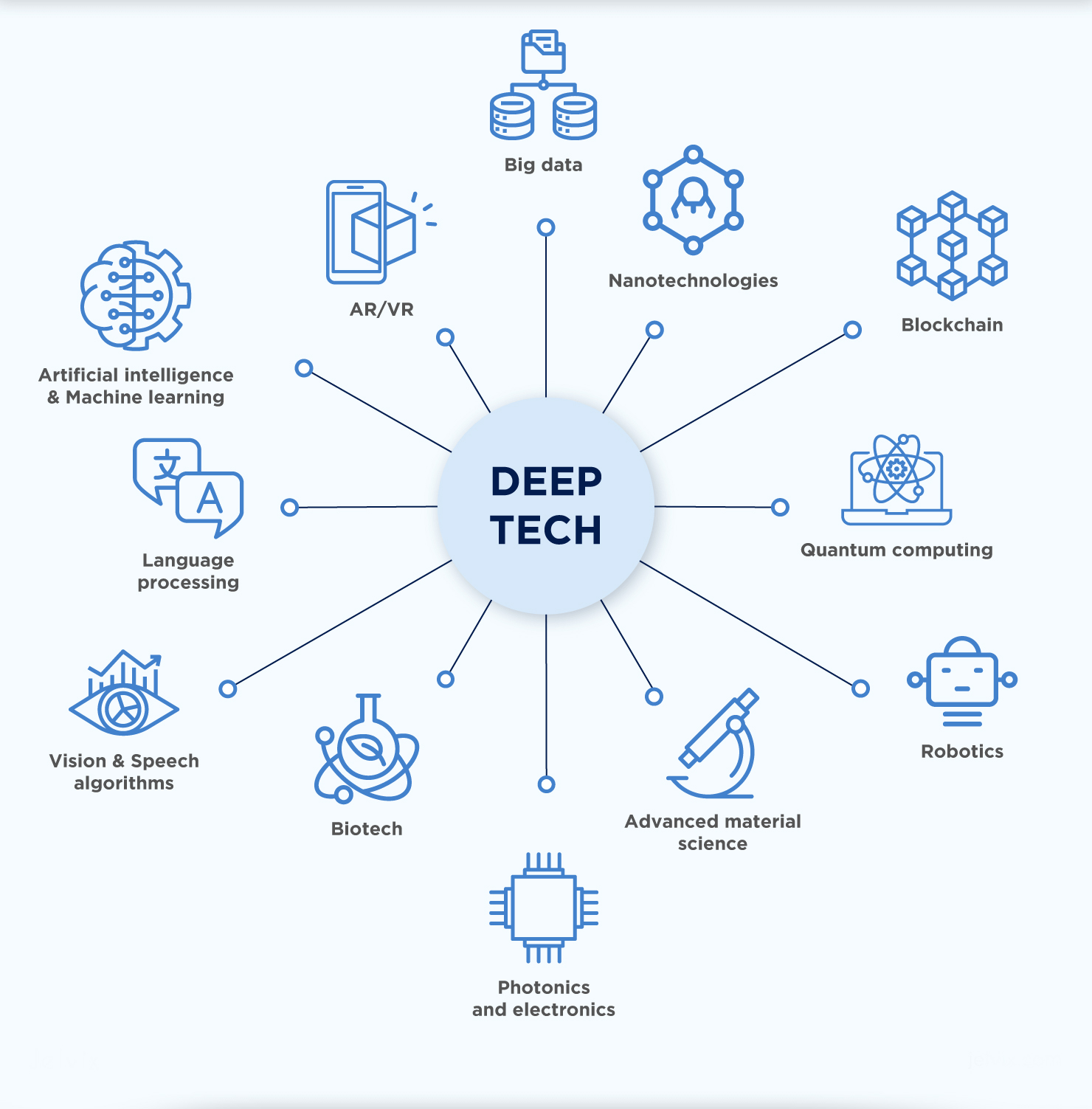Context:
On the 79th Independence Day, PM Narendra Modi laid out a futuristic vision for India's technological self-reliance (Atmanirbharta) in deep-tech areas such as artificial intelligence, semiconductors, space, quantum computing, and bioengineering. However, this vision demands not only technological innovation but also structural reforms in governance.
About Deep tech:
Deep tech refers to innovative technologies built upon significant scientific discoveries or complex engineering, aiming to solve major societal and environmental challenges. Unlike shallow tech, which involves incremental digital upgrades, deep tech startups focus on breakthrough innovations in fields like AI, biotechnology, quantum computing, and advanced materials. These ventures require substantial, long-term investment for research and development and can take decades to mature and reach market readiness.
Why deep tech matter for India:
- Deep tech is vital for India's transformation into a knowledge-driven economy. It powers innovation in advanced sectors like artificial intelligence, biotechnology, and the Internet of Things (IoT), creating new markets and boosting industrial productivity. This shift not only enhances economic efficiency but also lays the foundation for future industries, enabling India to move beyond traditional manufacturing-led growth.
- Deep tech also fosters entrepreneurship by enabling startups to pursue long-term, high-impact innovations, attracting global talent and investment. These ventures contribute to rising exports, job creation, and a strong innovation ecosystem.
- Deep tech addresses grand societal challenges—ranging from climate change and energy access to public health and cybersecurity. It strengthens national security by promoting indigenous technologies in defence, navigation, and critical infrastructure, aligning with the vision of Aatmanirbhar Bharat. Technologies like AI and quantum computing also enhance decision-making in governance and development sectors.
Current State of India’s Tech Ecosystem:
- India has made significant strides in digital technology, particularly in public digital infrastructure. Platforms like UPI, Aadhaar, CoWIN, and DigiLocker have revolutionized service delivery, financial inclusion, and digital governance. India now leads the world in per capita mobile data consumption, and cities like Bengaluru and Hyderabad have emerged as global tech hubs.
- Moreover, India’s skilled workforce plays a pivotal role in global innovation, with companies like Nvidia and IBM running major R&D centers in the country.
- However, these achievements are mostly concentrated in low-tech and mid-tech sectors, such as IT services, fintech, and social media. In contrast, India’s deep-tech ecosystem—involving AI, quantum computing, semiconductors, etc.—remains underdeveloped and import-dependent. There is also limited synergy between academia, industry, and government, which hinders research translation and innovation scale-up.
Colonial Bureaucracy issues for deep tech:
India's bureaucratic structure is a legacy of the colonial Indian Civil Service (ICS), originally designed to administer control, not to drive innovation. Post-independence, India retained the Westminster model with minimal structural reforms.
Today, this results in several governance challenges:
· Generalist dominance continues, with IAS officers often heading highly specialized departments (e.g., in AI or biotechnology).
· Lateral entry and domain expertise remain limited at senior levels.
· Red tape, a risk-averse culture, and internal promotions hinder accountability and innovation.
The Veerappa Moily Administrative Reforms Commission (2005) highlighted these issues and recommended:
· Lateral entry of experts
· Performance-based evaluations
· A code of ethics and accountability mechanisms
However, implementation has been piecemeal. Without reforming this outdated system, India’s ambition to lead in deep-tech will remain constrained.
Regulatory Bottlenecks for deep tech:
India’s regulatory environment remains a significant constraint on its deep-tech ambitions. While regulation is necessary for public interest and stability, excessive and outdated frameworks can stifle innovation and investment.
Problem Areas:
- Multiple and overlapping regulators: Many sectors—like digital finance, data protection, and biotech—are governed by multiple authorities, leading to confusion, delays, and inefficiencies.
- Regulatory overreach: In emerging sectors such as cryptocurrency, biotech, and AI, unclear or restrictive regulations create uncertainty, discouraging startups and investors from entering the space.
- Absence of innovation sandboxes: India lacks sufficient regulatory sandboxes or innovation zones, which are essential for controlled experimentation and piloting of new technologies.
- Colonial-era compliance burdens: Many business regulations are still based on outdated laws from the colonial period, resulting in excessive paperwork and procedural delays.
International Comparisons:
To strengthen its deep-tech ecosystem, India can draw valuable lessons from global leaders:
United States
-
- Independent regulatory bodies (e.g., FTC, FCC) ensure transparency, competition, and innovation.
- Massive public R&D funding through agencies like DARPA and initiatives like the CHIPS Act support foundational research in emerging technologies.
- A flexible bureaucracy enables domain experts to lead key institutions, allowing for more specialized and responsive governance.
- Independent regulatory bodies (e.g., FTC, FCC) ensure transparency, competition, and innovation.
China
-
- Adopts centralized planning with a clear national vision for deep-tech dominance.
- Strong state-industry collaboration accelerates innovation pipelines.
- Focus on long-term R&D investment and quick decision-making has helped China leapfrog in critical technologies like AI, 5G, and semiconductors.
- Adopts centralized planning with a clear national vision for deep-tech dominance.
Roadmap for Reform:
To realize India’s deep-tech potential and become a developed nation by 2047, institutional transformation is as crucial as technological advancement.
Immediate Priorities
· Reform UPSC to create fast-track recruitment paths for domain specialists.
· Promote lateral entry and encourage collaboration between bureaucracy, academia, and industry.
· Develop agile regulatory mechanisms, like regulatory sandboxes, to support innovation in emerging sectors.
· Modernize the judiciary through digital platforms and tech-specialized fast-track courts.
· Introduce performance-linked accountability in bureaucracy to align it with national innovation goals.
Long-Term Goals
· Build indigenous capabilities in critical deep-tech areas to reduce import dependence.
· Cultivate a culture of collaborative governance, breaking silos between institutions.
· Redesign institutional frameworks to match the scale and speed required for a tech-driven economy.
Conclusion
India’s deep-tech ambitions reflect a bold national vision, but their realization hinges not only on technology development but also on deep institutional reform.








